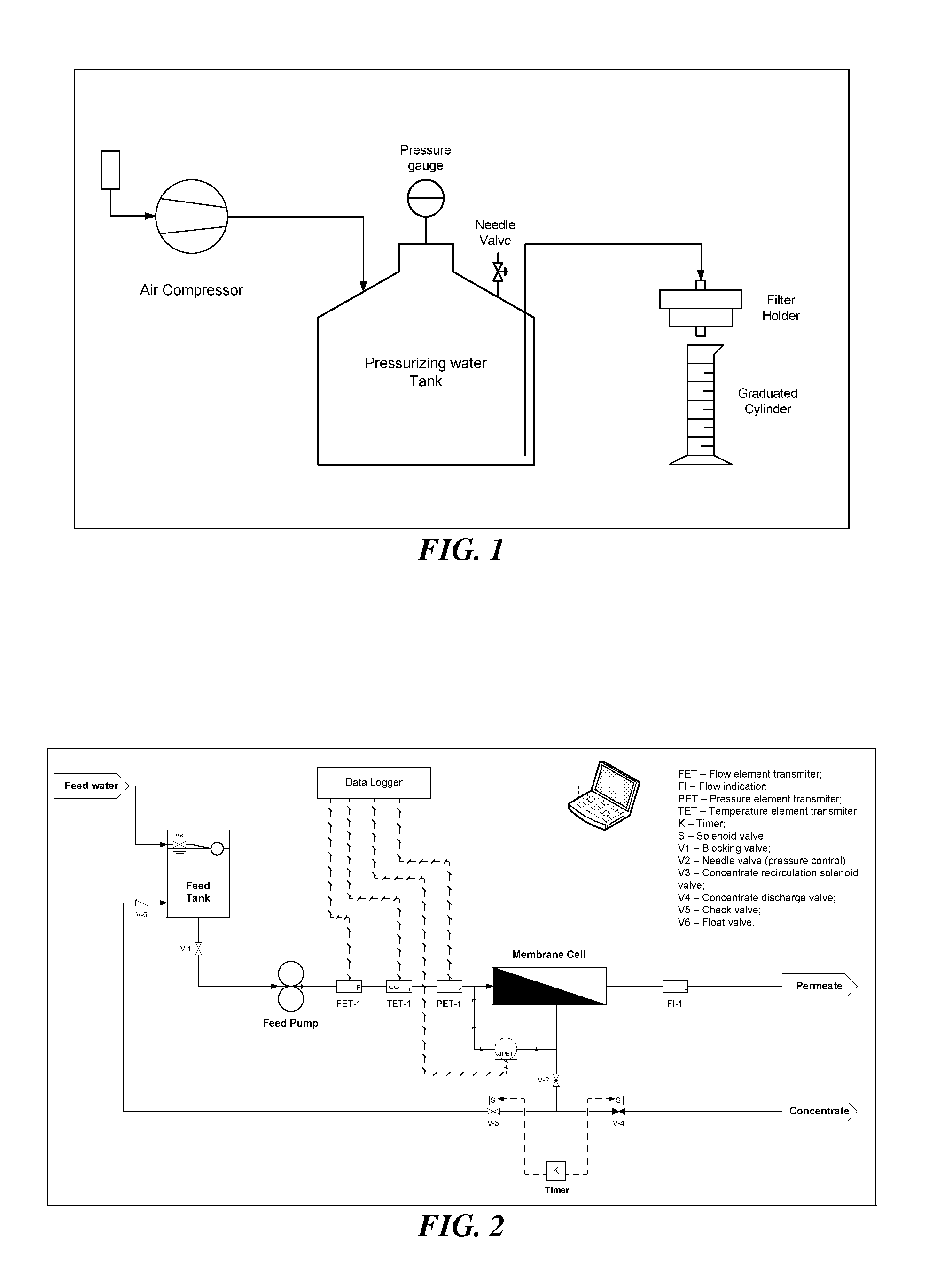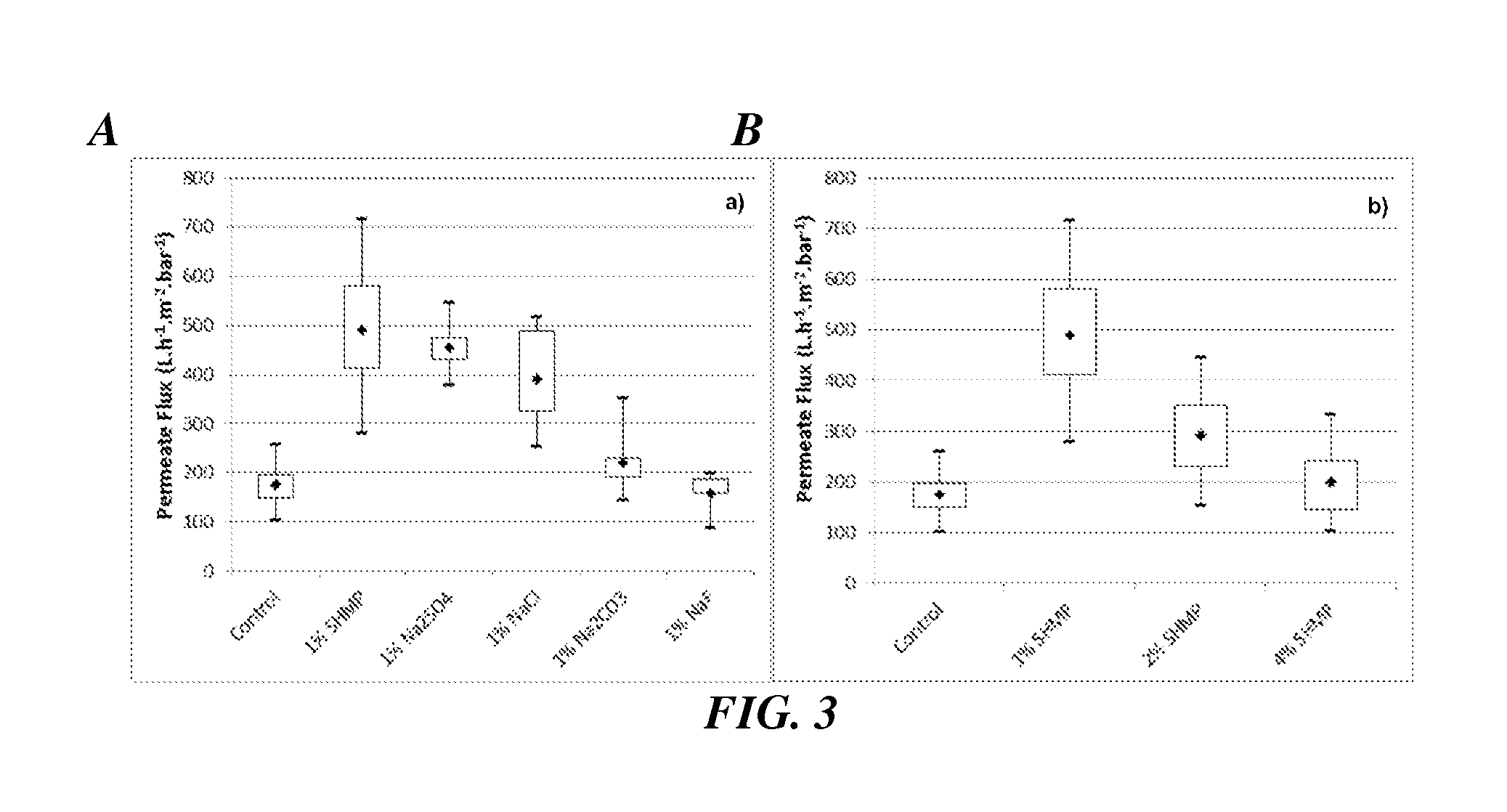Polyethersulfone filtration membrane
- Summary
- Abstract
- Description
- Claims
- Application Information
AI Technical Summary
Benefits of technology
Problems solved by technology
Method used
Image
Examples
example 1
Anion Dopant Effects on the Structure and Performance of Polyethersulfone Membranes
[0168]In regards to previous reports on inorganic salt casting solution dopants, the focus has been on how the metal cation affects the phase inversion thermodynamics and thus the resulting membrane morphology. Effects of inorganic salt dopants including zinc chloride, lithium bromide, lithium chloride, and potassium perchlorate have been previously examined. For example, a study by Kim and collaborators has shown that increasing the zinc chloride dopant concentration up to 3% weight to the weight of polysulfone resulted in a decreased membrane permeate flux and increased retention capacity (Sue Ryeon Kim, Kew Ho Lee, Mu Shik Jhon, The effect of ZnCl2 on the formation of polysulfone membrane, Journal of Membrane Science, 119 (1996) 59-6421). However, the membrane morphology was not examined in the study and the mechanism for decreased performance with zinc chloride addition remains unknown. Idris et a...
example 2
Effect of Clay Nanoparticles on the Structure and Performance of Polyethersulfone Ultrafiltration Membranes
[0200]Considering the limited set of data about the use of clay nanoparticles for membrane casting, in this work it was evaluated the use of different concentrations of unmodified clay nanoparticles on the morphology and performance of composite PES membranes, through Scanning Electron Microscopy (SEM) and dead-end and cross flow permeation tests, using ultrapure water, natural water, and polyethylene glycol solutions for Molecular Weight Cut-off (MWCO) determination. Phase inversion process was used for membrane casting and no other additive has been used in the dope casting solution or in the coagulation bath.
Experimental
[0201]Materials: For membrane casting polyethersulfone (PES) VERADEL 3000P with an average molecular weight of 63,000 g.mol−1 and number average molecular weight of 19,000 g.mol−1 was kindly donated by SolveyAdvanced Polymer and was used as it was received. P...
example 3
Specific Phosphate Salt Effects on Structure & Performance of Polyethersulfone Ultrafiltration Membranes
[0242]Membrane filtration is a widely used separation technology for aqueous mixtures. The application of membrane in water treatment has dramatically increased in the past decade due to the improved membrane quality and reduced cost. Ultra-filtration (UF) membranes have pores of 1 to 100 nm, and they are efficient in removing large organic molecules and bacteria. Therefore, UF serves as an important technique for drinking water purification as well as pretreatment of reverse osmosis.
[0243]Inorganic salts are widely used as additives to alter the polymeric membrane morphology and filtration performance when asymmetric UF membranes are prepared by phase inversion process. Lithium halides are the most commonly used salts. There are generally two pathways to consider the effects of the added salts: (i) the salts will interact with the solvent or the polymer molecules and change the c...
PUM
 Login to View More
Login to View More Abstract
Description
Claims
Application Information
 Login to View More
Login to View More - R&D
- Intellectual Property
- Life Sciences
- Materials
- Tech Scout
- Unparalleled Data Quality
- Higher Quality Content
- 60% Fewer Hallucinations
Browse by: Latest US Patents, China's latest patents, Technical Efficacy Thesaurus, Application Domain, Technology Topic, Popular Technical Reports.
© 2025 PatSnap. All rights reserved.Legal|Privacy policy|Modern Slavery Act Transparency Statement|Sitemap|About US| Contact US: help@patsnap.com



